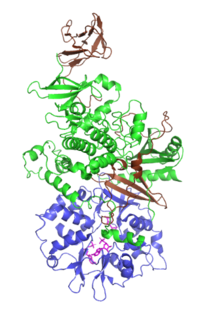
High glucose impairs osteogenic differentiation of embryonic stem cells via early diversion of beta‐catenin from Forkhead box O to T cell factor interaction
Sign Up to like & getrecommendations! Published in 2022 at "Birth Defects Research"
DOI: 10.1002/bdr2.2085
Abstract: Diabetes, which is characterized by an increase in blood glucose concentration, is accompanied by low bone turnover, increased fracture risk, and the formation of embryonic skeletal malformations. Yet, there are few studies elucidating the underlying… read more here.
Keywords: beta catenin; high glucose; osteogenic differentiation;

Endothelial cells' biophysical, biochemical, and chromosomal aberrancies in high‐glucose condition within the diabetic range
Sign Up to like & getrecommendations! Published in 2017 at "Cell Biochemistry and Function"
DOI: 10.1002/cbf.3251
Abstract: To date, many studies have been conducted to find out the underlying mechanisms of hyperglycemia‐induced complications in diabetes mellitus, attributed to the cellular pathologies of different cells—especially endothelial cells. However, there are still many ambiguities… read more here.
Keywords: biophysical biochemical; high glucose; glucose condition; endothelial cells ... See more keywords

Geniposide protects pancreatic β cells from high glucose‐mediated injury by activation of AMP‐activated protein kinase
Sign Up to like & getrecommendations! Published in 2017 at "Cell Biology International"
DOI: 10.1002/cbin.10758
Abstract: Our previous works indicated that geniposide could regulate glucose‐stimulated insulin secretion (GSIS), and improved chronic high glucose‐induced dysfunctions in pancreatic β cells, but the molecular mechanisms remain largely unknown. In the present study, we investigated… read more here.
Keywords: activated protein; high glucose; pancreatic cells; injury ... See more keywords

TSPAN8 alleviates high glucose‐induced apoptosis and autophagy via targeting mTORC2
Sign Up to like & getrecommendations! Published in 2022 at "Cell Biology International"
DOI: 10.1002/cbin.11870
Abstract: TSPAN8 mediates signal transduction from extracellular cues and regulates cell development, activation, growth, and motility. However, whether TSPAN8 is involved in the progression of diabetic nephropathy (DN) remains unclear. This study aimed to explore the… read more here.
Keywords: tspan8; apoptosis; apoptosis cells; high glucose ... See more keywords

Overexpression of TRIM32 promotes pancreatic β‐cell autophagic cell death through Akt/mTOR pathway under high glucose conditions
Sign Up to like & getrecommendations! Published in 2022 at "Cell Biology International"
DOI: 10.1002/cbin.11897
Abstract: Type 2 diabetes mellitus (T2DM) is a growing worldwide epidemic and is characterized by progressive pancreatic β‐cell dysfunction and insulin resistance. Tripartite motif protein 32 (TRIM32) belongs to the TRIM family protein and has been… read more here.
Keywords: cell; pancreatic cell; akt mtor; high glucose ... See more keywords

Zoledronate promotes osteoblast differentiation in high‐glucose conditions via the p38MAPK pathway
Sign Up to like & getrecommendations! Published in 2022 at "Cell Biology International"
DOI: 10.1002/cbin.11921
Abstract: Zoledronate (ZOL) were found to inhibit bone resorption in an animal model of diabetes, high glucose concentrations have been shown to decreased the osteogenesis‐related gene expression. But the molecular mechanism by which high glucose levels… read more here.
Keywords: expression; high glucose; differentiation; osteoblast differentiation ... See more keywords

Ghrelin regulates the proliferation and apoptosis of high glucose‐induced islet cells through the PI3K–Akt signaling pathway
Sign Up to like & getrecommendations! Published in 2023 at "Cell Biology International"
DOI: 10.1002/cbin.11981
Abstract: Ghrelin may have therapeutic value in mitigating insulin resistance and type 2 diabetes, based on which we further explore the action mechanism of ghrelin on islet cells in this research. In the course of experiments,… read more here.
Keywords: pi3k akt; islet cells; akt signaling; ghrelin ... See more keywords

High glucose promotes podocyte movement: From the perspective of single cell motility assay
Sign Up to like & getrecommendations! Published in 2023 at "Cell Biology International"
DOI: 10.1002/cbin.11996
Abstract: Podocytes are highly specialized glomerular epithelial cells that play a crucial role in maintaining the glomerular filtration barrier, impairment of which usually leads to proteinuria. The phenotypic alterations of podocytes are described to be one… read more here.
Keywords: cell; high glucose; single cell; motility assay ... See more keywords

Physiological assessment of high glucose neurotoxicity in mouse and rat retinal explants
Sign Up to like & getrecommendations! Published in 2019 at "Journal of Comparative Neurology"
DOI: 10.1002/cne.24805
Abstract: One of the tissues of the central nervous system most affected by diabetes is the retina. Despite a growing understanding of the biochemical processes involved in glucose toxicity, little is known about the physiological consequences… read more here.
Keywords: retinal explants; physiological assessment; high glucose; assessment high ... See more keywords

MicroRNA‐494 regulates high glucose‐induced cardiomyocyte apoptosis and autophagy by PI3K/AKT/mTOR signalling pathway
Sign Up to like & getrecommendations! Published in 2023 at "ESC Heart Failure"
DOI: 10.1002/ehf2.14311
Abstract: Diabetic cardiomyopathy (DCM) is one of the major cardiovascular complications of diabetes. However, the mechanism of DCM is not fully understood. Studies have confirmed that certain microRNAs (miRNAs/miRs) are key regulators of DCM. The aim… read more here.
Keywords: microrna 494; high glucose; cardiomyocyte apoptosis; apoptosis autophagy ... See more keywords

Salvianolic acid inhibits the effects of high glucose on vascular endothelial dysfunction by modulating the Sirt1‐eNOS pathway
Sign Up to like & getrecommendations! Published in 2019 at "Journal of Biochemical and Molecular Toxicology"
DOI: 10.1002/jbt.22245
Abstract: Salvianolic acid (SA) is known for improving blood circulation, scavenging hydroxyl radicals, and preventing platelet aggregation. The research explored whether SA can protect against cardiovascular disease induced by high glucose conditions. Our results indicate that… read more here.
Keywords: sirt1 enos; modulating sirt1; enos pathway; salvianolic acid ... See more keywords